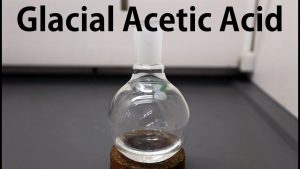
Manufacturing Business Ideas- Glacial Acetic Acid
Introduction –
The Global Glacial Acetic Acid market will witness an all-time rise owing to the increasing needs of medicines and needs of preserving those medicines. Asia has been the largest market for acetic acid which has shown tremendous signs to grow more on account of increasing demands. Also, the technological innovations in the manufacturing process has paved way for the irreplaceable growth in the market potentials.
Related Projects:- Chemicals (Organic, Inorganic, Industrial) Projects
The above graph shows how the Global Acetic acid Market is expected to rise by 2027. And it is absolutely clear that people all over the world thinking of a start-up in this sector can go ahead eyes closed as the market potential will only rise in the coming years.
Production of Acetic Acid –
Both synthetic and biological (i.e., bacterial fermentation) ways of producing acetic acid are possible. About 75% of global acetic acid production is synthetic. Still, the 25%, which is biological, holds utmost importance as food purity laws require vinegar used in foods to be of natural origin. Some other methods used for acetic acid production include methyl formate isomerization, conversion of syngas to acetic acid, and gas-phase oxidation of ethylene and ethanol.
Related Books:- Chemical Technology (Organic, Inorganic, Industrial), Fine Chemicals
– Methanol carboxylation
This Acetic Acid is produced by a reaction between methanol and carbon monoxide. The entire procedure includes two main steps: the rhodium-catalyzed Monsanto process and the iridium-catalyzed Captiva process.
– Acetaldehyde oxidation
Even though this method remains the second most crucial method for manufacturing acetic acid, it has no competition with the Methanol carbonylation technique. In this method, naphtha components are oxidized by oxygen and are converted to peroxides. These peroxides then decompose to form acetic acid. We react at temperatures and pressures as hot as possible while still keeping the chemical in the liquid state. This reaction also gives out numerous side-products that have high market value. We can also alter the reactions’ conditions to increase the production of side products to utilize their commercial value.
Related Videos:- Chemicals (Organic, Inorganic, Industrial)
– Ethylene Oxidation
Ethylene may help produce acetaldehyde through a process called the Wacker process, which can then be oxidized as described above.
– Oxidative fermentation
Bacteria such as Acetobacter can readily produce Acetic Acid if provided with sufficient oxygen. We have to keep Acetobacter in a dilute alcohol solution in a warm place to allow it to create vinegar. The industrial vinegar makers accelerate this process by supplying excess oxygen to the bacteria.
USES
Acetic acid has numerous uses, out of which one that holds the top position is the Vinyl acetate monomer. Some others include ester production and anhydride production.
– Vinyl Acetate is formed by the reaction of ethylene and acetic acid along with oxygen by using palladium as a catalyst. The polymerized form of vinyl acetate into polyvinyl acetate is an essential element in paints and adhesives.
– Inks, paints, and coatings use esters as a form of solvent. Esters are produced by a catalytic reaction between acetic acid and the corresponding alcohol. Acetates of ether are used as solvents for nitrocellulose, acrylic lacquers, varnish removers, and wood stains.
– Acetic anhydride is produced by condensation of two molecules of acetic acid. The anhydride is an acetylation agent. Its primary application is for cellulose acetate, a synthetic textile used for photographic film.
– Use as a solvent: Glacial acetic acid is known for its excellent recrystallizing properties during organic compounds’ purification.
– Medical: Tumors have shown a tendency to cure themselves post-injection of acetic acid. It has also been used as a part of cervical cancer screening in many developing world areas. It has also got useful antiseptic properties with a broad spectrum of activity against streptococci, staphylococci, pseudomonas, enterococci, etc.
Related Project:- Glacial Acetic Acid
HEALTH AND SAFETY
Acetic acid at high concentration can prove corrosive to the skin and needs to be taken care of while using.
Conclusion
Just as this report on The Potential Market escalation of Glacial Acetic Acid, you can get detailed reports on numerous products, which are taking humongous steps in the market only from the Niir Project Consultancy Services (NPCS). All the projects done by the employees of the NPCS are absolutely reliable. It will show various start-up ideas, business ideas and many more.
EVA_Art2021